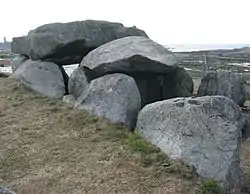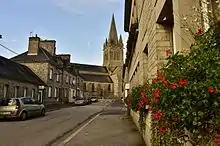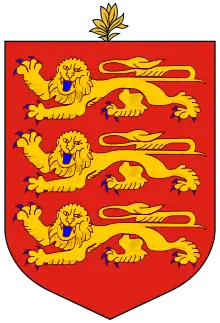Saint Saviour, Guernsey
St Saviour (Guernésiais: Saint Sauveux; French: Saint-Sauveur) is one of the ten parishes of Guernsey. It is situated on the west coast of the island, west of the parish of Castel, east of St Pierre du Bois, and south of Perelle bay.
St. Saviour | |
|---|---|
 Le Catioroc (dolmen) in Saint Saviour | |
 Flag | |
.gif) Location of St. Saviour in Guernsey | |
| Coordinates: 49°27′0″N 2°37′23″W | |
| Crown Dependency | Guernsey, Channel Islands |
| Government | |
| • Electoral district | West |
| Area | |
| • Total | 6.2 km2 (2.4 sq mi) |
| Population (2019) | |
| • Total | 2,765 |
| • Density | 450/km2 (1,200/sq mi) |
| Time zone | GMT |
| • Summer (DST) | UTC+01 |
People from Saint Sauveux were nicknamed "fouormillaons" in Guernésiais, the insular Norman language of the island. The postal code for street addresses in this parish begins with GY7.
Features
St Saviour is home to the States of Guernsey reservoir, providing a water supply to the whole island.[1][2]: 153
The parish contains many protected historic constructions,[3] including the parish church, St Saviour church[2]: 154 [4] and outside it, the parish war memorial;[5] the 14th century St Apolline's chapel;[2]: 154 [6] the Victorian Fort Richmond; the artillery batteries of Mont Chinchon and Perelle of Napoleonic Wars vintage, numerous German fortifications of World War II and several Neolithic sites principally at Le Crocq and Le Catioroc (Mont Chinchon).
The once extensive megalithic site at Le Crocq now consists mainly of two menhirs, although the hedge boundaries in the area contain many of the stones from the destruction of the monument a couple of hundred years previously.[7] At Le Catioroc again there is a lot less than historically; this area featuring more than any other in the witchcraft trials of the 16th and 17th century and appears to have suffered some deliberate destruction, though Le Trepied Dolmen remains.[8]
World War II fortifications, built during the 1940-45 German occupation of the Channel Islands include the St Saviours Tunnel complex beneath the church[2]: 153 and parts of the Batterie Mirus,[9] although there are other PAK (Anti Tank), FLAK (Anti Aircraft), artillery, machine gun installations.
Abreuvoirs - places for cattle to drink - are also found in Saint Saviour.[10]
Politics
Saint Saviour comprises part of the West administrative division with Torteval, Forest and St. Pierre-du-Bois
In the 2016 Guernsey general election there was a 3,188 or 74% turnout to elect five Deputies. Those elected (in order of votes received) being Al Brouard, Andrea Dudley-Owen, Emilie Yerby, David De Lisle and Shane Langlois.
The parish is managed by twelve elected officials known as the Douzane.[11]
Twin towns
Saint Saviour is twinned with:
- Montebourg, Normandy, France
 File:Montebourg_-_L'église_Saint-Jacques.jpgMontebourg - L'église Saint-Jacques
File:Montebourg_-_L'église_Saint-Jacques.jpgMontebourg - L'église Saint-Jacques File:Montebourg,_Jumelage,_Saint_Saviour,_Guernsey.jpgSaint Saviour Partnership Committee
File:Montebourg,_Jumelage,_Saint_Saviour,_Guernsey.jpgSaint Saviour Partnership Committee
References
- "St Saviours Reservoir". Visit Guernsey.
- Dillon, Paddy. Channel Island Walks. Cicerone Press Limited, 1999. ISBN 9781852842888.
- "PROTECTED BUILDINGS". Environment - Guernsey government.
- "St Saviour's church".
- "St Saviour's Parish Memorial, Guernsey". Great War CI.
- "St Apolline chapel". Church of England.
- "Le Crocq, La Longue Pierre". Megalithic Guernsey.
- "Le Trépied". BBC.
- "Batterie Mirus". Festung Guernsey. Archived from the original on 2016-03-07.
- "Guernsey Abreuvoirs". La Société Guernesiaise.
- "St Saviours > Douzaine". Paroisse de Saint Sauveur. Retrieved 16 September 2016.
